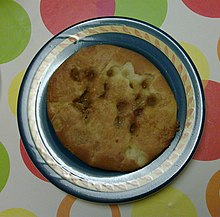Sugar pie
 Sugar pie from northern France | |
| Alternative names | Sugar cream pie, finger pie, tarte au sucre |
|---|---|
| Type | Pie |
| Main ingredients | Flour, butter, vanilla, cream, sugar |
Sugar pie is a typical dessert of the western European countries of Northern France and Belgium; in the province of Quebec and French-Canadian communities throughout Canada and New England, where it is called tarte au sucre;[1] and the Midwestern United States.[2][3]
Recipe

Sugar pie is a single-crust pie with a filling made from flour, butter, salt, vanilla, cream, and brown sugar or maple syrup[1] (sometimes both). When baked, these ingredients combine into a homogeneous mixture similar to caramel. If maple syrup is used, it might be referred to as maple pie. The ideal sugar cream pie is supposed to be like Santa Claus in that it should shake "like a bowl full of jelly."[4][opinion][unreliable source?] The name "finger pie" for the dessert was due to stirring the pie during baking with one's finger; it was stirred this way to avoid breaking the crust.[2]
The European version is vaguely reminiscent of an American "transparent pie" (the name in the Midwestern and Southern United States for a version of pecan pie without the pecans), of English Canadian butter tarts, or of English treacle tart.
The Indiana version of a sugar pie, known as "sugar cream pie", is believed to have originated with Quaker settlers who came from North Carolina in the early 19th century, and thereafter settled in east-central Indiana, particularly around the cities of New Castle, Portland, Richmond, and Winchester.
The Amish also popularized sugar cream pie, making the pie easy to find where they populated. In particular, the pie is a favorite in the Pennsylvania Dutch areas, much as is shoofly pie, a similar dessert. Shakers also have a variant of the pie.[2] However, as the Shakers had to abandon their community of West Union (Busro) (near modern-day Vincennes, Indiana) in 1827, their only presence in Indiana ever (1810–1827), it is unlikely that they made the dessert popular in the state.[5]
The largest producer of these pies is Wick's Pies, whose plant is in Winchester, Indiana, and makes 750,000 sugar cream pies a year. They are recognizable for their nutmeg dusting and shallow depth in a disposable aluminum pan. The recipe Wick's uses came directly from a family recipe originating from the nineteenth century. The pies sell in 25 states.[4][6][7]
See also
Notes
- ^ a b "Canadian Comfort Food: A collection of uniquely Canadian Cuisine". The Canadian Encyclopedia. Historica Canada. Retrieved 10 May 2016.
- ^ a b c Stradley, Linda. "History of Sugar Cream Pie". What's Cooking America. Retrieved 2009-01-11.
- ^ Slater p. 248
- ^ a b Evans, Tim (January 10, 2009). "Sweet dream of a pie may get state honor". The Courier Journal. Archived from the original on January 19, 2013. Retrieved 2009-01-10.
- ^ Stuttgen p. 277
- ^ Richmond, Bill (January 6, 2009). "Legislature to consider designating sugar cream - Hoosier Pie". Winchester News-Gazette. Retrieved 2009-01-11.
- ^ Stuttgen p. 254
References
- Stuttgen, Joanne Raetz (2007). Cafe Indiana: A Guide to Indiana's Down-Home Cafes. Terrace Books. ISBN 978-0-299-22494-3.
- Slater, Shirley (2008). Frommer's Exploring America by RV. Frommer's. ISBN 978-0-470-18404-2.

